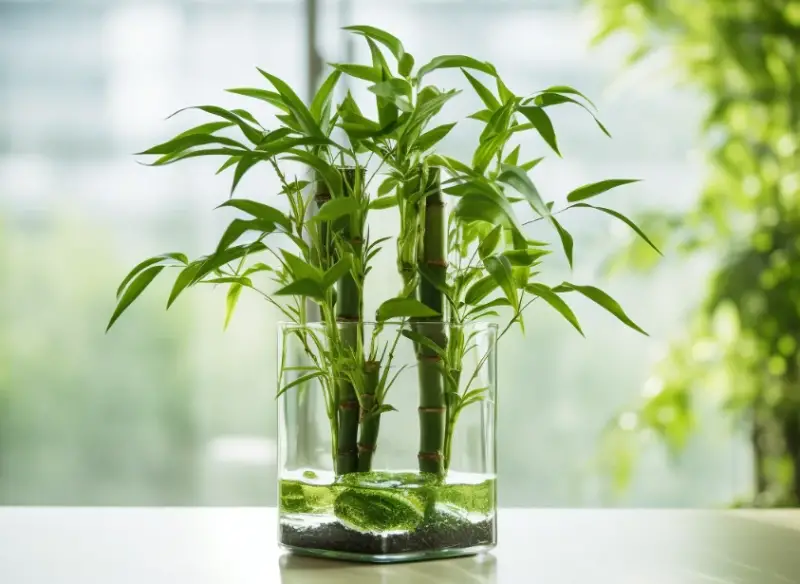Lucky bamboo plant, scientifically known as Dracaena sanderiana, is a popular indoor plant celebrated not only for its striking appearance but also for its symbolism of good fortune and prosperity in many cultures. Easy to care for and remarkably resilient, lucky bamboo has become a favorite among both novice and experienced gardeners.
This comprehensive guide will walk you through the essential aspects of growing and caring for lucky bamboo, including optimal light conditions, watering needs, soil requirements, and how to troubleshoot common issues.
Whether you’re looking to add a touch of greenery to your home or seeking a meaningful gift for a loved one, understanding how to care for this versatile plant is key to ensuring its health and longevity. Join us as we delve into the most detailed practices for nurturing your lucky bamboo and reaping its benefits
About Lucky Bamboo Plant

Lucky bamboo, also known as friendship bamboo or ribbon plant, is a popular houseplant, though it is not a true bamboo. Its botanical name is Dracaena sanderiana, and it belongs to the Asparagaceae family. This perennial shrub can grow between 1 to 5 feet tall and 1 to 2 feet wide when cultivated indoors. It thrives best in partial shade, making it ideal for indoor environments with filtered light.
Lucky bamboo can grow in either water or in moist but well-drained soil, with a preference for slightly acidic conditions. While the plant can bloom during the fall and winter seasons, it rarely flowers indoors. If it does bloom, the flowers are small and white. Hardy in USDA zones 10–11, lucky bamboo is commonly grown as an indoor plant since it cannot survive in outdoor conditions in most climates.
The plant originates from Africa and has become widely associated with good fortune and positive energy. However, it’s important to note that lucky bamboo is toxic to animals, so it should be kept out of reach from pets like cats and dogs.
Lucky Bamboo Plant Care
Lucky bamboo is famous for its resilience and low maintenance, making it an excellent choice for novice gardeners or those who tend to forget to water their plants. To keep lucky bamboo thriving, the most important factor is ensuring it has access to good quality water.
Place your lucky bamboo in a spot that receives filtered or indirect sunlight, as direct sun can cause leaf burn. If growing in soil, use a well-draining potting mix. Alternatively, you can plant it in pebbles with about an inch of water at the base of the container.
For watering, only use distilled or pure spring water, as tap water contains chemicals that may harm the plant. If using tap water, let it sit for 24 hours before using it. If your plant is growing in pebbles, ensure you change the water weekly to prevent stagnation.
Avoid exposing the plant to cold drafts, and keep it in an environment where the temperature remains at least 65°F (18°C).
Light Requirements for Lucky Bamboo
Lucky bamboo thrives in bright, filtered sunlight, mimicking the natural light conditions found under a rainforest canopy. This type of light allows the plant to photosynthesize effectively without the risk of damage. Direct sunlight should be avoided at all costs, as it can scorch the delicate leaves, leading to brown tips and an unhealthy appearance. Instead, placing lucky bamboo near a window with sheer curtains or in a well-lit room will provide the optimal lighting conditions.
Interestingly, lucky bamboo is more tolerant of low light than it is of excessive brightness. In fact, this plant can survive in indirect light for extended periods. However, if you observe that the plant is stretching toward the light source or its once vibrant green leaves start to fade, it may be an indication that it requires more light. Such stretching is a natural response as the plant seeks to reach a better-lit area.
To promote even growth and prevent the plant from leaning to one side, it’s beneficial to rotate your lucky bamboo regularly. By ensuring that all sides of the plant receive light, you can encourage balanced growth and a fuller appearance. Additionally, if your lucky bamboo is kept in a space with lower light levels, consider using grow lights to supplement its needs. These lights can mimic natural sunlight and provide the necessary energy for your plant to thrive, particularly during darker months or in windowless rooms.
Soil Requirements for Lucky Bamboo
Lucky bamboo is a versatile plant that can thrive in various growing mediums, making it an excellent choice for both beginners and seasoned gardeners. When grown in well-drained, rich potting soil, the soil should be kept moist but not overly saturated. This balance is essential, as too much water can lead to root rot, which is detrimental to the plant’s health. A high-quality potting mix that retains moisture while allowing for proper drainage will provide the ideal environment for lucky bamboo to flourish.
In addition to soil, lucky bamboo can also be cultivated in pebbles or in a vase filled with water. When using this method, it is important to maintain at least an inch of standing water at all times to ensure that the roots remain hydrated. This method closely resembles the plant’s natural habitat and can be an attractive way to display lucky bamboo indoors.
For optimal growth, consider using distilled or purified water if you choose the water method, as lucky bamboo is sensitive to the chemicals often found in tap water, such as chlorine and fluoride. Maintaining the right moisture level and using the appropriate growing medium will help keep your lucky bamboo healthy and thriving.
Water Requirements for Lucky Bamboo
Lucky bamboo is notably sensitive to chlorine and other chemicals typically found in tap water, which can adversely affect its health. While tap water can be used, it’s advisable to avoid it if you have hard water, which contains a high concentration of minerals. To mitigate the effects of chlorine, consider watering your lucky bamboo with bottled or distilled water, or allow tap water to sit out for 24 hours before use. This process lets chlorine evaporate, making the water safer for your plant.
If your lucky bamboo is grown in a water vase filled with pebbles, it’s crucial to change the water weekly. This routine helps prevent diseases and unpleasant odors from developing in stagnant water. Ensure that the water consistently covers the roots, as this is vital for the plant’s health. Depending on the environmental conditions, you may need to add a bit of water every two to seven days to maintain proper levels. Additionally, performing a complete water change every two to three months is recommended, or more frequently if the water starts to emit a foul odor.
Temperature and Humidity for Lucky Bamboo
Lucky bamboo thrives in warmer temperatures, with an ideal range between 65°F and 90°F (18°C to 32°C). To ensure its well-being, avoid placing your plant near any drafts—whether hot or cold—including areas near air conditioners, heating vents, or drafty windows. Sudden temperature fluctuations can stress the plant, leading to wilting or yellowing leaves.
In terms of humidity, lucky bamboo is quite adaptable and doesn’t require any special humidity levels. Average household humidity is sufficient, so there’s no need to increase humidity artificially. This makes lucky bamboo a low-maintenance option for most indoor environments, provided that you maintain consistent temperatures and avoid extreme conditions.
Fertilizer for Lucky Bamboo
Lucky bamboo is relatively low-maintenance when it comes to fertilization. A single drop of liquid fertilizer each month is generally sufficient for most lucky bamboo arrangements. For those seeking a more tailored approach, specialty fertilizers designed specifically for lucky bamboo are also available, providing the nutrients necessary for optimal growth.
If your lucky bamboo is grown in water, it typically requires feeding every two months or so. In this case, using a very weak liquid fertilizer is recommended to avoid overwhelming the plant with nutrients. It’s important to note that healthy, lucky bamboo roots are often red, so don’t be alarmed if you see red roots floating in the vase; this is a normal characteristic of the plant.
Pruning Lucky Bamboo
Pruning is an essential practice for maintaining the health and appearance of your lucky bamboo plant. Over time, it may become top-heavy, or intricate shapes may begin to lose their form, necessitating some trimming. However, it’s generally advisable not to cut the main stalk of the plant. Instead, focus on the offshoots; use sterile snippers to cut them back to within an inch or two of the main stem. This technique encourages new shoots to emerge, resulting in fuller growth. If you wish to discourage additional growth from the cut ends, consider dipping them in paraffin, which can help seal the cuts and inhibit further sprouting.
Interestingly, the unique shapes often associated with lucky bamboo are not achieved through trimming but rather by manipulating the plant’s light exposure. To create these fascinating forms, rotate the stalks in front of a light source, which encourages the plant to grow towards the light. Professionals may even grow stalks on their sides to produce spiraling shapes. At home, a simple method involves placing your lucky bamboo under a three-sided box to control its light exposure. By paying close attention to growth rates and rotating the plants slowly and regularly, you can achieve similar artistic shapes
Common Pests of Lucky Bamboo
Lucky bamboo, like many indoor tropical plants, is vulnerable to a range of common pests that can affect its health and vitality. Among the most frequent culprits are white mealybugs, green aphids, and spider mites. These pests can be a nuisance, but they can often be managed with relatively simple methods.
One effective approach to pest control is to remove them by hand when you notice an infestation. This can be done gently with a cotton swab or by simply wiping them off the plant. Additionally, you can wash the entire plant using a very mild solution of liquid dish soap and water. This method not only helps to remove pests but also eliminates any moldy spots that may have formed on the plant’s surface. After washing, be sure to rinse the plant thoroughly to prevent any soap residue from lingering, which could harm the plant.
For ongoing pest management, it’s essential to regularly inspect your lucky bamboo for signs of trouble, ensuring that you can address any issues before they escalate.
Propagating Lucky Bamboo
Propagating lucky bamboo is a straightforward process that can be done at any time using stem cuttings. However, it’s essential to note that the new plants may not have the same shape or appearance as the original plant. To successfully propagate lucky bamboo, follow these steps:
Start by taking a stem cutting from the main stalk, ensuring that it includes at least one leaf joint. This leaf joint is crucial, as it contains the growth nodes from which new roots will develop. After cutting, trim the leaves back to expose these nodes, which will facilitate root growth.
Next, place the bare cutting into a container filled with enough distilled water to cover the bottom of the cutting completely. Keeping the water clean and fresh is vital for the health of the cutting; change the water regularly to prevent any buildup of bacteria. Over the next 30 days, you should begin to see the development of red roots emerging from the cutting.
Once the roots have formed, you can transfer the cutting into a more permanent home. For instance, place the rooted stalk in a decorative vase filled with water and pebbles, or pot it in well-draining soil. This transition will help the new plant continue to grow and thrive.
Potting and Repotting Lucky Bamboo
Repotting lucky bamboo is essential for its growth and overall health. You should consider repotting when there is less than one inch of space between the stalks and the edge of the vessel, when the vessel starts to feel wobbly with the plant inside, or if the stalks have grown too tall to be supported properly. Adequate space allows the roots to spread out, providing necessary support for the plant. Additionally, the water level should be sufficient to submerge the roots but not cover the stalks themselves, ensuring proper air circulation.
If you find that your lucky bamboo has outgrown its current container, repotting is a straightforward process. Start by choosing a clean container that is slightly larger than the one currently being used. Carefully dig out the lucky bamboo from the pebbles, if present. If the plant is in a pot without pebbles, simply remove it and place it in the new container filled with fresh water.
Before transferring the bamboo, clean any pebbles that will be reused to eliminate dirt and debris. Set aside some pebbles to place on top of the roots after repotting. When moving the plant to its new container, gently nestle the roots within the pebbles and add more as needed to cover the roots completely. This provides stability and ensures that the plant remains upright while allowing for proper drainage.
Common Problems with Lucky Bamboo Plant
Although lucky bamboo is known for its resilience and low maintenance, it can still encounter several issues that may affect its health. If your plant dies, it’s important to remember that it doesn’t signify bad luck; rather, it may indicate that the plant didn’t receive the ideal care or that its natural lifespan has come to an end.
One of the most frequent problems arises from the quality of water, as lucky bamboo is sensitive to chemicals like chlorine. To prevent issues, it’s essential to regularly change the water and use high-quality water, such as distilled or bottled water.
Browning leaf tips are often a sign of exposure to chlorinated or heavily treated water. This can lead to leaf damage and potentially kill the plant over time. To address this, remove any affected leaves with sterile scissors, and be sure to take out dead leaves from the water to prevent rot and bacterial growth.
Black roots may indicate various issues. The best course of action is to promptly cut away the black roots and place the remaining healthy stalks into a clean container with fresh water. This helps prevent further damage.
Algae growth is commonly seen in clear vases where light penetrates the water, encouraging algae proliferation. To combat this, clean the vase thoroughly with mild dish detergent and water, and consider switching to an opaque container if algae becomes a persistent issue.
Yellow leaves typically indicate too much sun exposure or excessive fertilizer. To remedy this, stop fertilizing and relocate the plant to a shadier area. Conversely, brown leaves can suggest dry air or contaminated water. Increasing humidity by misting the plant regularly can help, as can ensuring that you’re using the right water quality.
Lastly, if you notice mushy stalks, this is usually a sign of rot, often due to poor water quality or a fungal infection. In such cases, it’s best to remove any decaying stalks immediately to prevent the spread of rot to healthier parts of the plant. If there are surviving stalks, clean the container thoroughly and replace the water or substrate.






